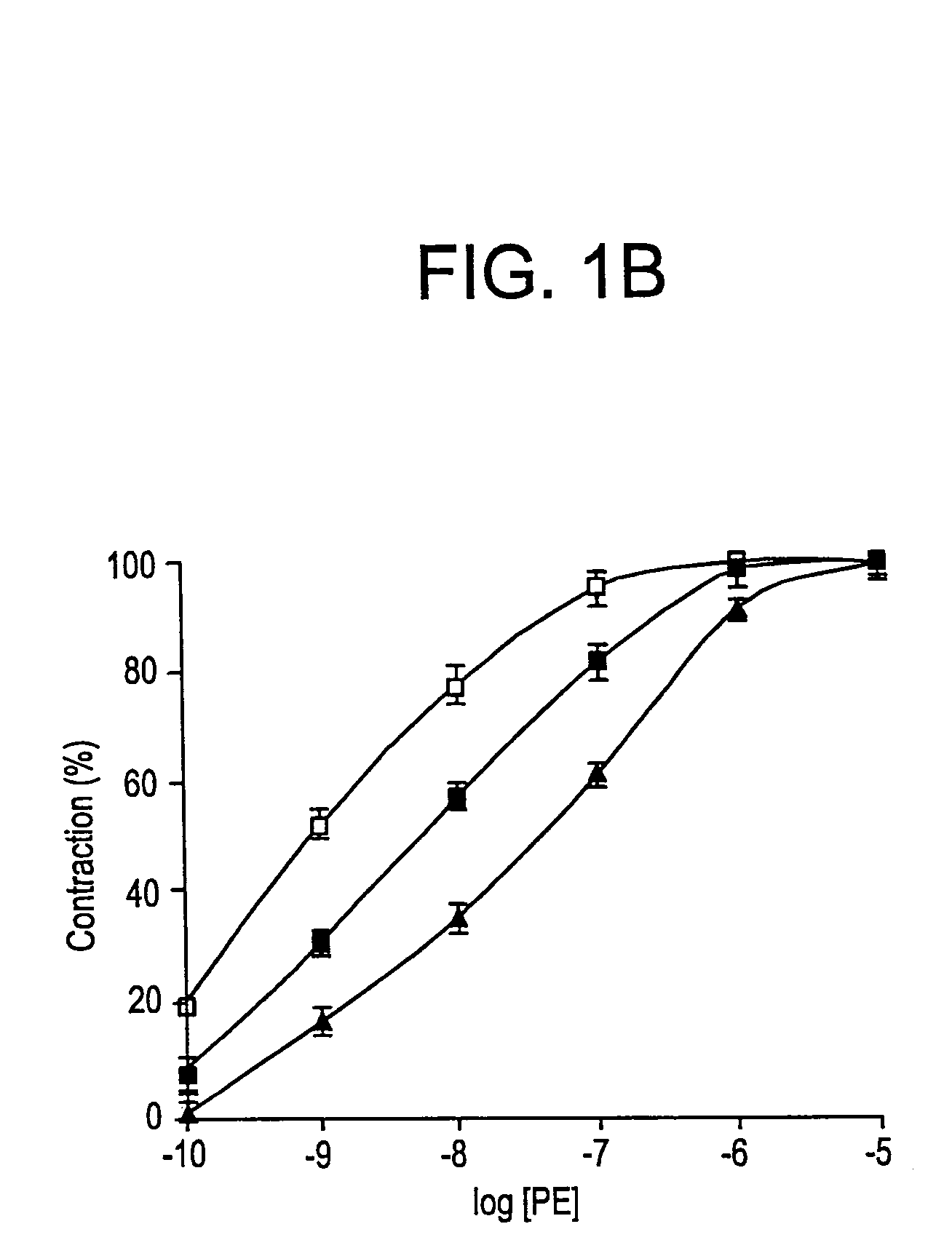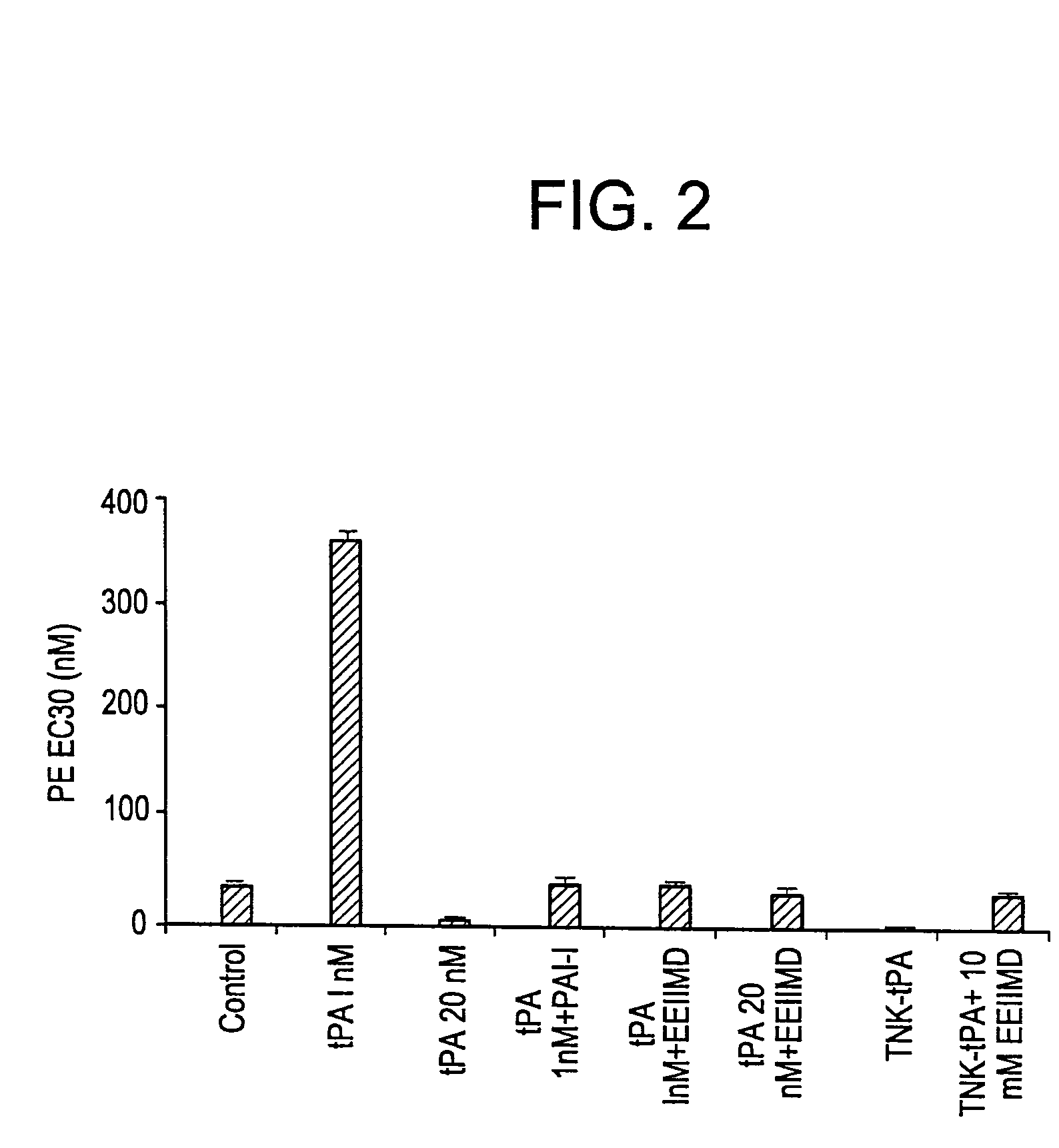Peptides for regulation of urokinase (uPA) and tissue type (tPA) plasminogen activator and method of optimizing therapeutic efficacy
a technology of plasminogen activator and urokinase, which is applied in the direction of peptide sources, extracellular fluid disorder, fibrinogen, etc., can solve the problems of reducing the concentration of pai-1 and exposing patients to secondary intracerebral hemorrhage, so as to prevent the occurrence of side effects of tpa and prevent any side effects
- Summary
- Abstract
- Description
- Claims
- Application Information
AI Technical Summary
Benefits of technology
Problems solved by technology
Method used
Image
Examples
example 1
[0075]The effect of TNK-tPA on PE-induced contraction was compared with the effect of tPA, in the isolated aorta rings. The experimental procedure followed has been described earlier (Haj-Yehia A, Nassar T, Sachais B, Kuo A, Bdeir K., Al-Mehdi A-B, Mazar A, Cines D, Higazi A A-R. Urokinase-derived peptides regulate vascular smooth muscle contraction in vitro and in vivo. FASEB J 2000; 14:1411–1422.
[0076]FIG. 1A shows that 1 nM tPA inhibited PE-induced vasoconstriction. FIG. 1B shows that at the same concentration (1 nM) TNK-tPA exerted an opposite effect to that of tPA on the contraction of aorta rings. 1 nM of TNK-tPA stimulated the vasoconstriction induced by PE.
[0077]Since the concentration of tPA used in the previous experiments was in the physiological range, but was much below the therapeutic range, the effect of higher concentrations of tPA variants on vasoactivity was examined FIG. 1A shows that increasing the concentration of rtPA produced a similar effect to that induced b...
example 2
[0079]In an attempt to understand the basis for the modification in the vasoactivity of TNK-tPA, the role of the PAI-1 docking site in the process was examined. FIG. 2 shows that the rtPA provasodilatation as well as pro-vasoconstrictive effects are inhibited by equimolar concentrations of PAI-1.
[0080]PAI-1 interacts with tPA through independent sites; the catalytic site and a docking site, present in the amino acids 2196 to 299. The PAI-1 docking site is mutated in TNK-tPA. To examine in greater detail the role of the PAI-1 docking site in the vasoactivity of TNK-tPA specifically and of rtPA in general, we examined the effect of the PAI-1 derived hexapeptide SEQ ID NO:1 that correspond to the amino acid residues 350 to 355 of PAI-1 (the epitope in PAI-1 that interacts with the tPA docking site (Madision E L, Goldsmith E J, Gerard R D, Getbing M J H, Sambrook J F, Bassel-Duby R S. Amino acid residues that affect interaction of tissue plasminogen activator with plasminogen activator ...
example 3
[0083]The effect of revertase and TNK-tPA on the PE induced vasocontraction was studied in presence or absence of the LRP antagonist (RAP) or anti LRP antibodies. The results obtained shown in FIG. 3, indicate that the vasoactive effect of tPA and / or TNK-tPA is totally abolished by the anti-LRP antibodies as well as by the LRP antagonist rRAP.
PUM
| Property | Measurement | Unit |
|---|---|---|
| Time | aaaaa | aaaaa |
| Mass | aaaaa | aaaaa |
| Therapeutic | aaaaa | aaaaa |
Abstract
Description
Claims
Application Information
 Login to View More
Login to View More - R&D
- Intellectual Property
- Life Sciences
- Materials
- Tech Scout
- Unparalleled Data Quality
- Higher Quality Content
- 60% Fewer Hallucinations
Browse by: Latest US Patents, China's latest patents, Technical Efficacy Thesaurus, Application Domain, Technology Topic, Popular Technical Reports.
© 2025 PatSnap. All rights reserved.Legal|Privacy policy|Modern Slavery Act Transparency Statement|Sitemap|About US| Contact US: help@patsnap.com



